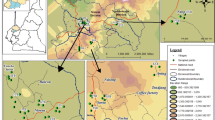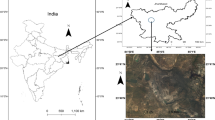Abstract
Forest reclamations have been very commonly used on post-mining sites in central Europe and offer great opportunities for research of soil formation process. Antonín forest arboretum near Sokolov, Czech Republic, reclaimed and afforested between 1972 and 1974 was the opportunity to compare the influence of only the vegetation variable. In this research, physical and chemical soil properties from the uppermost mineral 5 cm of 23 stands (11 broadleaved and 12 coniferous) were analysed and compared. Soil pH, bulk density, porosity, water retention capacity, organic and total carbon and nitrogen content, plant available nutrients and potentially toxic elements were analysed. From the species tested, the soil properties that can generally be considered beneficial were noticed in Alnus glutinosa, Fagus sylvatica, Tilia cordata, Pyrus communis, Picea pungens and Pinus ponderosa. On the other hand, species that have not shown these soil properties were Betula pendula, Larix decidua, Picea abies, Pinus rotundata, Pinus strobus and Pinus sylvestris. It is also worth mentioning that, although some species have shown soil properties that can be considered more or less favourable from a pedological point of view, the choice of species for afforestation of post-mining sites needs to consider other factors as well, like stand health, growth potential, affinity to climatic, hydrological, and other factors, potential invasiveness, susceptibility to pathogens.
Graphical abstract

Access this article
We’re sorry, something doesn't seem to be working properly.
Please try refreshing the page. If that doesn't work, please contact support so we can address the problem.












Similar content being viewed by others
Availability of data and material
Not applicable.
Code availability
Not applicable.
References
Angst Š (2017) Transformation of aliphatic and aromatic components of litter during decomposition and its relevance to soil environment and soil biota. University of South Bohemia, Faculty of Science, School of Doctoral Studies in Biological Sciences
Borůvka L, Kozák J, Mühlhanselová M, Donátová H, Nikodem A, Němeček K, Drábek O (2012) Effect of covering with natural topsoil as a reclamation measure on brown-coal mining dumpsites. J Geochem Explor 113:118–123. https://doi.org/10.1016/j.gexplo.2011.11.004
Borůvka L, Kozák J (2001) Interpretation of soil variability on a reclaimed dumpsite. Soil science: past, present and future: Proc of the joint meeting of the czech society of soil science and the soil science society of America and International Conference of the Czech Society of Soil Science, Prague, Czech Republic, Sept 16–20, pp 17–19
Bradshaw AD (1997) Restoration of mined lands: using natural processes. Ecol Eng 8(4):255–269. https://doi.org/10.1016/S0925-8574(97)00022-0
Brom J, Nedbal V, Procházka J, Pecharová E (2012) Changes in vegetation cover, moisture properties and surface temperature of a brown coal dump from 1984 to 2009 using satellite data analysis. Ecol Eng 43:45–52. https://doi.org/10.1016/j.ecoleng.2011.03.001
Chodak M, Niklińska M (2010) The effect of different tree species on the chemical and microbial properties of reclaimed mine soils. Biol Fertil Soils 46(6):555–566. https://doi.org/10.1007/s00374-010-0462-z
Chuman T (2015) Restoration practices used on post mining sites and industrial deposits in the Czech Republic with an example of natural restoration of granodiorite quarries and spoil heaps. J Lands Ecol Czech Repub 8(2):29–46. https://doi.org/10.1515/jlecol-2015-0007
Cools N, Vesterdal L, De Vos B, Vanguelova E, Hansen K (2014) Tree species is the major factor explaining C: N ratios in European forest soils. For Ecol Manage 311:3–16. https://doi.org/10.1016/j.foreco.2013.06.047
Coppin NJ, Bradshaw AD (1982) The establishment of vegetation in quarries and open-pit non-metal mines. In: Mining Journal Books, London
FAO (2015) Soil is a non-renewable resource. Food and Agriculture Organization of the United Nations, pp 2–3
Filcheva E, Noustorova M, Gentcheva-Kostadinova S, Haigh MJ (2000) Organic accumulation and microbial action in surface coal-mine spoils, Pernik, Bulgaria. Ecol Eng 15(1–2):1–15. https://doi.org/10.1016/S0925-8574(99)00008-7
Frouz J, Pižl V, Cienciala E, Kalčík J (2009) Carbon storage in post-mining forest soil, the role of tree biomass and soil bioturbation. Biogeochemistry 94(2):111–121. https://doi.org/10.1007/s10533-009-9313-0
Frouz J, Livečková M, Albrechtová J, Chroňáková A, Cajthaml T, Pižl V, Háněl L, Starý J, Baldrian P, Lhotáková Z, Šimáčková H, Cepáková Š (2013) Is the effect of trees on soil properties mediated by soil fauna? A case study from post-mining sites. For Ecol Manage 309:87–95. https://doi.org/10.1016/j.foreco.2013.02.013
Frouz J, Vobořilová V, Janoušová I, Kadochová Š, Matějíček L (2015) Spontaneous establishment of late successional tree species english oak (Quercus robur) and European beech (Fagus sylvatica) at reclaimed alder plantation and unreclaimed post mining sites. Ecol Eng 77:1–8. https://doi.org/10.1016/j.ecoleng.2015.01.001
Hendrychová M (2008) Reclamation success in post-mining landscapes in the Czech Republic: a review of pedological and biological studies. J Lands Stud 1(February):63–78
Horodecki P, Jagodziński AM (2019) Site type effect on litter decomposition rates: a three-year comparison of decomposition process between spoil heap and forest sites. Forests. https://doi.org/10.3390/f10040353
Kohlová MB, Máca V, Melichar J, Pavelčík P (2021) How high is the recreation value of successional forests growing spontaneously on coal mine spoil heaps? Forests 12(2):1–19. https://doi.org/10.3390/f12020160
Lima AT, Mitchell K, O’Connell DW, Verhoeven J, Van Cappellen P (2016) The legacy of surface mining: remediation, restoration, reclamation and rehabilitation. Environ Sci Policy 66:227–233. https://doi.org/10.1016/J.ENVSCI.2016.07.011
Michopoulos P, Kostakis M, Thomaidis NS, Pasias I (2021) The influence of forest types on manganese content in soils. Folia for Pol Series A 63(1):1–9. https://doi.org/10.2478/ffp-2021-0001
Monterroso C, Alvarez E, Fernández Marcos ML (1999) Evaluation of Mehlich 3 reagent as a multielement extractant in mine soils. Land Degrad Dev 10(1):35–47. https://doi.org/10.1002/(SICI)1099-145X(199901/02)10:1%3c35::AID-LDR319%3e3.0.CO;2-6
Mudrák O, Frouz J, Velichová V (2010) Understory vegetation in reclaimed and unreclaimed post-mining forest stands. Ecol Eng 36(6):783–790. https://doi.org/10.1016/j.ecoleng.2010.02.003
Murray D (2011) Measuring pH in water or CaCl2 using a pH meter. PH meter procedure, pp 1–19. http://www.sfu.ca/soils/lab_documents/pH_Meter_Procedures.pdf
Pietrzykowski M (2019) Tree species selection and reaction to mine soil reconstructed at reforested post-mine sites: central and eastern European experiences. Ecol Eng X. https://doi.org/10.1016/j.ecoena.2019.100012
Pospíšil F (1964) Fractionation of humus substances of several soil types in Czechoslovakia. Rostlinna Vyroba 10:567–580
Rawlik M, Kasprowicz M, Jagodziński AM, Kaźmierowski C, Łukowiak R, Grzebisz W (2021) Tree species have a greater influence on species composition of the herb layer than soil texture on a forested post-mining area. Land Degrad Dev 32(5):2013–2024. https://doi.org/10.1002/ldr.3852
Remeš J, Šíša R (2007) Biological activity of anthropogenic soils after spoil-bank forest reclamation. J for Sci 53(7):299–307. https://doi.org/10.17221/2075-jfs
Sheoran AS, Sheoran V, Poonia P (2008) Rehabilitation of mine degraded land by metallophytes. Min Eng J 10(3):11–16
Sheoran V, Sheoran AS, Poonia P (2010) Soil reclamation of abandoned mine land by revegetation: a review. Int J Soil Sediment Water 3(2):13
Šourková M, Frouz J, Šantrůčková H (2005) Accumulation of carbon, nitrogen and phosphorus during soil formation on alder spoil heaps after brown-coal mining, near Sokolov (Czech Republic). Geoderma 124(1–2):203–214. https://doi.org/10.1016/j.geoderma.2004.05.001
Spasić M, Borůvka L, Vacek O, Drábek O, Tejnecký V (2021) Pedogenesis problems on reclaimed coal mining sites. Soil Water Res 16(3):137–150. https://doi.org/10.17221/163/2020-SWR
Spasić M, Vacek O, Vejvodová K, Tejnecký V, Polák F, Borůvka L, Drábek O (2023) Determination of physical properties of undisturbed soil samples according to V. Novák. Methodsx 10:102133. https://doi.org/10.1016/J.MEX.2023.102133
Spasić M, Dere A, Vejvodová K, Vacek O, Drábek O, Borůvka L (2022) Profile development and soil properties of 3 lignite forest reclamation chronosequences. In: BIOGEOMON 2022 10th international symposium on ecosystem behavior 195
Treschevskaya E, Tichonova E, Golyadkina I, Malinina T (2019) Soil development processes under different tree species at afforested post-mining sites. IOP Conf Series Earth Environ Sci. https://doi.org/10.1088/1755-1315/226/1/012012
ÚKZÚZ. (n.d.). Průzkum výživy lesa (1996–2011)—klasifikační kritéria. Průzkum Výživy Lesa (1996–2011) – Klasifikační Kritéria. https://eagri.cz/public/web/ukzuz/portal/hnojiva-a-puda/publikace/pruzkum-lesnich-pud-publikace/pruzkum-vyzivy-lesnich-porostu-publikace/pruzkum-vyzivy-lesa-96-2011/vysledky-pvl/
ÚKZÚZ (2016) Analýza půd I—Jednotné pracovní postupy. Ústřední kontrolní a zkušební ústav zemědělský
Vacek Z, Cukor J, Vacek S, Podrázský V, Linda R, Kovařík J (2018) Forest biodiversity and production potential of post-mining landscape: opting for afforestation or leaving it to spontaneous development? Central Eur for J 64(2):116–126. https://doi.org/10.1515/forj-2017-0036
Vacek Z, Cukor J, Vacek S, Linda R, Prokůpková A, Podrázský V, Gallo J, Vacek O, Šimůnek V, Drábek O, Hájek V, Spasić M, Brichta J (2021) Production potential, biodiversity and soil properties of forest reclamations: opportunities or risk of introduced coniferous tree species under climate change? Eur J for Res. https://doi.org/10.1007/s10342-021-01392-x
Vopravil J, Formánek P, Heřmanovská D, Khel T, Jacko K (2021) The impact of agricultural land afforestation on soil water content in Central Bohemia. J for Sci 67(11):512–521. https://doi.org/10.17221/108/2021-JFS
Woś B, Chodak M, Józefowska A, Pietrzykowski M (2022) Influence of tree species on carbon, nitrogen, and phosphorus stocks and stoichiometry under different soil regeneration scenarios on reclaimed and afforested mine and post-fire forest sites. Geoderma. https://doi.org/10.1016/j.geoderma.2022.115782
Acknowledgements
The authors would like to express their gratitude to the members of Dendrology Institute of Polish Academy of Sciences in Kórnik for their hospitality, whilst this paper was in preparation and valuable information and experience gained there with the help of the researchers of this institution.
Funding
This research was financed by the Project “Centre for the investigation of synthesis and transformation of nutritional substances in the food chain in interaction with potentially harmful substances of anthropogenic origin: comprehensive assessment of soil contamination risks for the quality of agricultural products” of the European Structural and Investment Funds Operational Programme Research, Development and Education of the European Union and the Ministry of Education, Youth and Sports of the Czech Republic, No. CZ.02.1.01/0.0/0.0/16_019/0000845.
Author information
Authors and Affiliations
Contributions
MS was contributed to writing—original Draft, conceptualization, methodology, investigation, formal analysis, visualisation. OV was contributed to conceptualization, methodology, investigation, formal analysis. KV was contributed to writing—review and editing, investigation. VT was contributed to supervision, resources. PV was contributed to investigation. PK was contributed to investigation. FP was contributed to investigation. RV was contributed to formal analysis. LB was contributed to project administration, funding acquisition. OD was contributed to conceptualization, methodology, investigation, formal analysis, supervision.
Corresponding author
Ethics declarations
Conflict of interest
The authors declare that they have no known competing financial interests or personal relationships that could have appeared to influence the work reported in this paper. The authors declare the following financial interests/personal relationships which may be considered as potential competing interests: Financial support was provided by Ministry of Education Youth and Sports of the Czech Republic.
Ethical approval
All authors have read and accepted the Ethical Responsibilities of Authors.
Consent to participate
All authors have given consent to participate.
Consent for publication
All authors have given consent for publication.
Additional information
Communicated by Agustin Merino.
Publisher's Note
Springer Nature remains neutral with regard to jurisdictional claims in published maps and institutional affiliations.
Rights and permissions
Springer Nature or its licensor (e.g. a society or other partner) holds exclusive rights to this article under a publishing agreement with the author(s) or other rightsholder(s); author self-archiving of the accepted manuscript version of this article is solely governed by the terms of such publishing agreement and applicable law.
About this article
Cite this article
Spasić, M., Vacek, O., Vejvodová, K. et al. Which trees form the best soil? Reclaimed mine soil properties under 22 tree species: 50 years later—assessment of physical and chemical properties. Eur J Forest Res 143, 561–579 (2024). https://doi.org/10.1007/s10342-023-01637-x
Received:
Revised:
Accepted:
Published:
Issue Date:
DOI: https://doi.org/10.1007/s10342-023-01637-x




